How to beat the heat this summer: Smart energy-saving tips for your business.
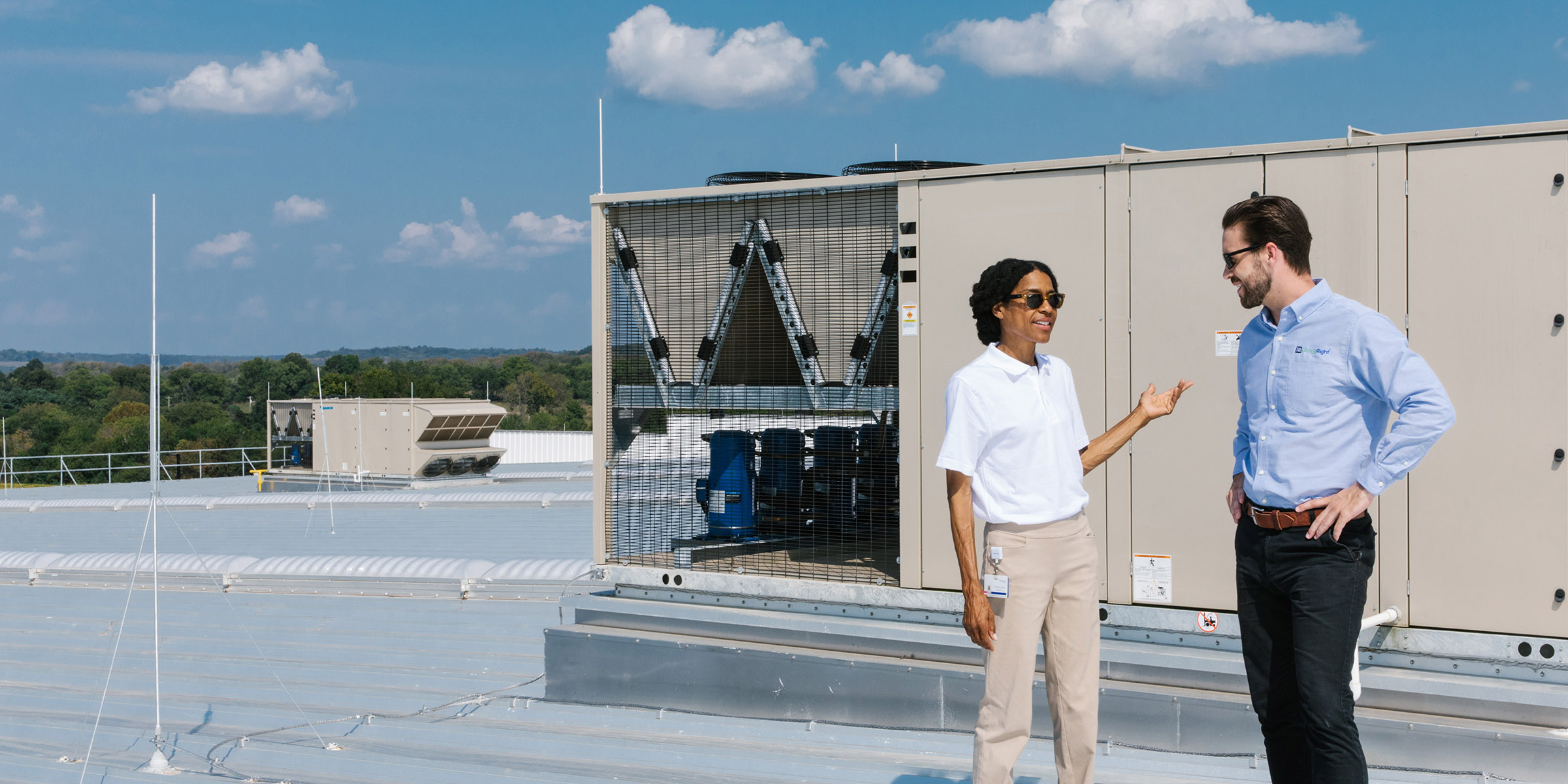
When the temperatures rise, so can your energy bills — but they don’t have to. With a few smart upgrades and efficiency moves, your business can stay cool without overheating your budget. Here are some energy-saving tips to reduce business energy use.

1. Tune up your HVAC system.
Your HVAC system works harder in the summer, which means small issues can turn into big energy drains. Schedule a seasonal inspection to check refrigerant levels, clean coils and replace filters. It’s one of the easiest ways to boost performance and cut unnecessary costs. Or check out our HVAC incentives, which can help you replace aging units while improving comfort and efficiency year-round.

2. Upgrade to smart thermostats.
Smart or programmable thermostats help you avoid cooling empty spaces. Set temperature schedules based on work hours and occupancy zones to ensure you’re only using energy when and where you need it.

3. Switch to energy efficient lighting.
Still using outdated bulbs? LED lighting uses up to 75% less energy and generates less heat than traditional lighting. That means your cooling system doesn’t have to work as hard either — a win-win in the summer months.
Check out our LED lighting incentives to learn more.

4. Take advantage of TVA EnergyRight® incentives.
From high-efficiency HVAC systems to lighting retrofits, TVA EnergyRight offers incentives to help businesses make smart upgrades.

5. Seal air leaks and improve insulation.
Warm air creeping in and cool air leaking out can quietly drive up your summer energy bills. Inspect doors, windows and ductwork for leaks and add weather stripping or insulation where needed. Sealing up your space keeps cool air in, hot air out and your HVAC system from working overtime.
Source: sba.gov
Stay cool and stay ahead.
Getting your business ready for hot weather doesn’t have to be complicated or costly. With these energy-saving tips for businesses, you can reduce energy costs and keep your operations running efficiently all season long.
Not sure where to begin?
Connect with a TVA Energy Expert to get started.
Energy efficiency for business: the overlooked growth strategy you can’t afford to ignore.

When you think about growing your business, energy efficiency probably isn’t the first thing that comes to mind. But what if it should be?
Whether you’re running a boutique, a print shop, a restaurant or a commercial office space — every dollar counts. Energy efficiency isn’t just about cutting costs. It’s a smart strategy that frees up resources, improves your space and sets your business up for long-term success. Here’s how thinking differently about your energy use could fuel your next big move.
1. Every dollar saved is a dollar to reinvest.
Let’s start with the obvious: trimming energy waste cuts costs. But the real opportunity is what you can do with those savings.
Lower utility bills mean more budget flexibility to reinvest in things that drive growth, like marketing, staffing, equipment, or expanding your product line. And thanks to TVA EnergyRight®, those upgrades don’t have to wait. With cash incentives for things like LED lighting and HVAC improvements, your payback period gets even shorter.
For example, a retail shop that replaces outdated lighting with LEDs could reduce energy use by up to 75%. Combine that with TVA incentives, and those savings could help cover a new POS system, signage or digital advertising campaign.
Explore TVA lighting and HVAC incentives.
Source: energy.gov

2. Energy efficiency for business builds resilience.
The past few years have shown how quickly things can change—utility costs rise, supply chains strain and margins shrink.
Recent data from the report, “From Insight to Implementation: Business Perspectives on Energy Efficiency Investments,” shows that energy accounts for up to 24% of annual operating costs for many businesses, and the percentage is continuing to climb.
Businesses that run more efficiently are better positioned to weather those storms. Reducing your energy consumption now can help you maintain stability, even when operating costs or external factors become unpredictable. It’s one more way to future-proof your business.
Sources: energyefficiencymovement.com; entrepreneur.com
3. Customers care about sustainability.
Being energy-conscious isn’t just good for your bottom line—it’s good for your brand.
Today’s consumers are paying attention to how businesses operate. Whether you’re serving a socially conscious Gen Z audience or local clients who care about community impact, small shifts in sustainability, like switching to efficient lighting or optimizing HVAC, can set you apart.
You don’t have to be a certified green business to make a difference. Highlighting smart energy moves on your website or signage helps show customers that you’re thoughtful, forward-thinking and part of the solution.
Source: mckinsey.com
4. Comfortable spaces boost productivity.
Lighting and HVAC upgrades don’t just cut energy use—they make your space more enjoyable to work and shop in. Bright, natural-looking LEDs can enhance product displays and reduce eye strain. Efficient HVAC systems create more consistent temperatures and improve air quality. These improvements can boost employee productivity and create an atmosphere that encourages people to stay longer and spend more.
Switching to bright, natural-looking LEDs can significantly improve visibility, reduce eye strain, and create a more inviting environment for both customers and employees. According to the U.S. Department of Energy, LED lighting not only consumes up to 75% less energy than traditional bulbs but also improves visual clarity and color rendering — key for retail settings where product presentation matters.A well-functioning, energy-efficient HVAC system helps maintain consistent temperatures, reduces humidity, and improves indoor air quality. Poor indoor air quality is linked to headaches, fatigue, and reduced cognitive performance, which can impact employee productivity.
Sources: alconlighting.com; ansi.org; energy.gov; hsph.harvard.edu
5. TVA EnergyRight makes it easy.
Investing in comfort isn’t just a feel-good move—it’s a business strategy that pays off. With TVA EnergyRight incentives available for lighting and HVAC upgrades, creating a better environment is easier and more affordable than ever.
The best part? You don’t have to do it alone.
In partnership with your local power company, TVA EnergyRight offers a variety of programs and incentives to help businesses upgrade their lighting, HVAC systems, and overall energy use, often with no pre-approval required, that reduce your upfront costs.Not sure where to start? Talk to a TVA Energy Expert, so you can identify the biggest opportunities to save.
Reach out to your local power company representative or click the link below to connect with a TVA Energy Expert today.
Powering progress: Five key energy management takeaways from the TVA Industrial Summit 2025
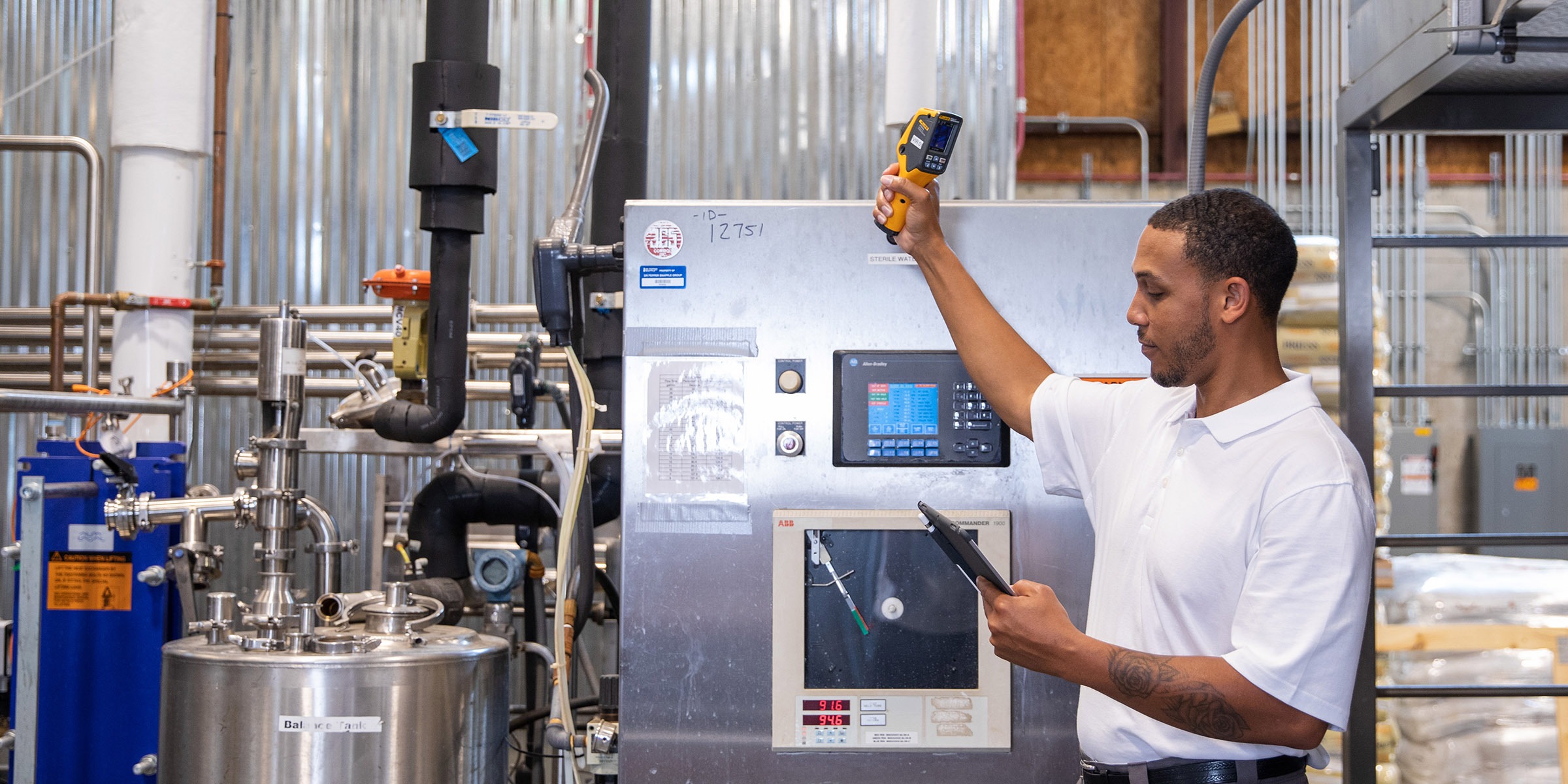
The 2025 TVA Industrial Summit brought together hundreds of energy leaders, facility managers, engineers and sustainability professionals from across the seven-state region to explore the power of industrial energy management, incentives and strategic approaches. Here are five key takeaways you don’t want to miss.
1. Incentives are a game-changer for industrial energy management projects.
TVA EnergyRight’s energy incentive programs are helping turn “maybe someday” projects into fully funded energy upgrades. Case in point: Goodyear received over $845,000 in TVA incentives, cutting more than 11 million kWh in energy use. Incentives don’t just reduce upfront capital costs—they also accelerate payback periods, expand project scope and create competitive advantages by enabling facilities to operate more efficiently than their peers.

Pro tip: Not sure where to start? Incentive upgrades that don’t require pre-approval, such as New Construction LED Lighting and HVAC, are one of the easiest ways to begin.
2. Strategic Energy Management (SEM) is the new business advantage.
Energy isn’t just a line item — it’s a resource you can manage. SEM helps businesses build a culture of continuous improvement by integrating energy-saving practices into everyday operations. Facilities that implement SEM see, on average, a 5-15% energy cost savings, along with better asset utilization, reduced downtime and increased employee engagement.

Case study: A Tennessee-based food processor saved nearly $60,000 by reducing refrigeration discharge, upgrading lighting, fixing compressed air leaks and launching a “Shut It Off” campaign.
3. Demand response = revenue opportunity.
Industrial facilities aren’t just reducing costs—they’re earning credits by participating in TVA’s Demand Response programs. With load growth accelerating and extreme weather events increasing, programs like PowerFlex reward facilities for curtailing energy use during peak demand.

Facilities with 5 MW of interruptible load could earn up to $568,200 in annual capacity credits and $48,000 in energy credits*. That’s real money back in your budget.
*Using current pricing for E5+C30 enrollment option. These credits reflect enrollment in 96 hours of capacity per TVA fiscal year. All credits listed are estimates for illustrative purposes only. Actual credit values will vary according to enrollment options selected.
4. Energy assessments make it easy to get started.
If you don’t have a dedicated energy team or you’re unsure where your biggest savings lie, TVA offers free energy assessments to help identify lighting, HVAC, refrigeration, compressed air and process improvement opportunities. The best part? TVA’s Preferred Partners Network can handle the work, from installation to incentive applications.

“The TVA incentive program provides us the opportunity to reduce our overall energy costs and identify future opportunities to control consumption.”
-Pat Jodon, Goodyear Plant Manager
5. Partnerships drive long-term success.
Whether you’re working with a TVA EnergyRight Energy Expert or connecting through your local power company, collaboration is at the heart of the industrial energy efficiency transformation. Events like the TVA Industrial Summit give leaders space to share strategies, troubleshoot challenges, and build partnerships that lead to real results.

Facilities that have completed SEM initiatives report millions in kWh savings and hundreds of thousands in energy cost reductions. One [state-based] furniture manufacturer saved over $600,000 by identifying air leaks, installing a capacitor bank, upgrading to LED lighting and replacing CO2 lasers.
Ready to take the next step?
TVA EnergyRight is here to help you unlock savings and performance in your facility. Whether it starts with an energy assessment or a strategic partnership, the resources are ready, and the support is built for you. Reach out to your local power company representative or click the link below to connect with a TVA Energy Expert today.
How to get a free commercial energy audit.

When you’re running a large facility, energy efficiency can fall lower on the priority list — until your energy bill spikes. That’s where TVA EnergyRight® steps in with a no-cost opportunity that can deliver real value: a free, engineer-led energy assessment for industrial and commercial customers.
If your business has an electric demand of 1 MW or more (or your power bill hits around $25,000 or more per month), you’re likely eligible. Here’s how it works — and how it can help you uncover energy-saving upgrades, reduce operating costs and make your facility more productive.
1. It’s free and customized for your facility.
This isn’t a generic audit. One of our TVA energy experts will assess your specific operations, looking for inefficiencies, outdated equipment and opportunities to boost productivity through energy improvements.
You’ll walk away with energy efficiency tips that include:
- Recommendations tailored to your facility.
- Estimated savings.
- A custom list of potential upgrades.
Request a free energy assessment today.
2. You’ll get connected with vetted contractors.
We connect you directly with professionals in our Preferred Partners Network (PPN) to bring your project to life. These contractors are already trained in our incentive process and energy efficiency standards, helping streamline your upgrade process from assessment to installation. If you already have a contractor on board, we’re flexible. We can also work with your contractor.
3. You may qualify for incentives to help pay for upgrades.
Here’s where things really pay off: Many of the upgrades TVA recommends come with incentives, often worth up to $3 million annually per company.
These may include:
- Up to $0.15 per kWh saved for qualifying custom energy-saving projects.
- $80 to $250 per ton for high-efficiency HVAC upgrades.
- $0.13 per kWh saved for lighting retrofits or $0.10 per kWh for new builds.
Check out our current incentives and explore your possibilities.
4. You’ll identify new ways to hit sustainability goals.
Whether you’re working toward ESG targets or just trying to cut operational waste, the energy assessment provides data and direction. Many participants use the recommendations as a launchpad for achieving long-term sustainability outcomes.
5. It’s fast, easy and built for busy teams.
You don’t need to prep a bunch of documentation or shut down production to get free energy efficiency tips. TVA’s assessment process is designed to be low-disruption, with a clear next-step path once the evaluation is complete.
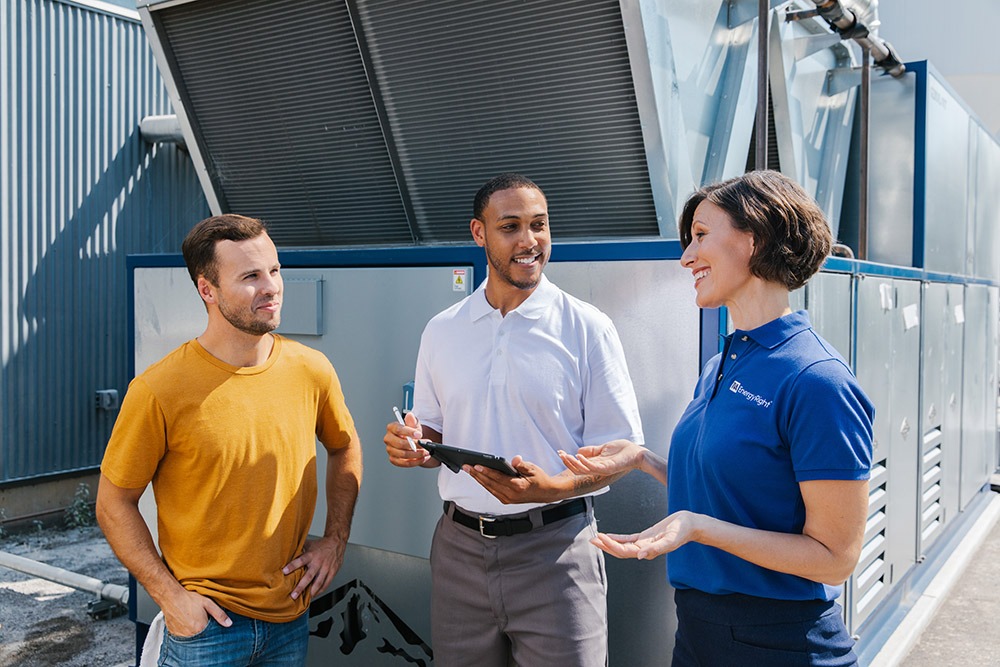
Ready to start? Here’s how.
Getting your free commercial energy audit is simple. Even if you’re not sure of your exact demand, TVA can help you figure it out. It could be your first step toward major cost savings—and a smarter, more efficient operation.
Connect with a TVA Energy Expert to get started.
Will a smart thermostat save money?

Inquiring minds want to know! Will a smart thermostat save money? Can you really trim your energy bill with a smart thermostat?
Absolutely. And we did the data digging, so you don’t have to.
How will a smart thermostats save money? Let’s find out!
They learn how to reduce energy waste for you.
Wifi-connected smart thermostats use machine learning to understand when you’re home and what temperatures you prefer. Over time, they create a custom heating and cooling schedule that minimizes energy use when you don’t need it, making them far easier to use than a conventional programmable thermostat.

ENERGY STAR and the U.S. Department of Energy report that you can save an average of 8%-10% on your heating and cooling costs using a smart thermostat.
Translation: If your average energy bill is $150 each month, you could save $140-$150 in just one year. This savings would more than cover the cost of many smart thermostats on the market.
Programs like Smart Thermostat Rewards, offered by TVA EnergyRight and participating local power companies, can help you save even more.
Remote access prevents unnecessary heating and cooling.
Never say “Whoops! I did it again. I forgot to turn the air conditioning off.” Although a smart thermostat will learn your routines, you can still mix things up and adjust your settings anytime, anywhere using an app on your smartphone.
This kind of control prevents unnecessary energy use and even gives you the power to pre-condition (pre-cool or preheat) your home before you walk through the door. We call that a convenience and efficiency double-play.
Geofencing and motion sensors optimize efficiency and comfort.
If accessing an app sounds like too much work, rest easy: many smart thermostats use geofencing (based on your phone’s proximity to home) to detect when you’re away and when you’re on your way home and automatically adjust temperature settings for you.
Some also use motion sensors to determine which rooms are in use, prioritizing comfort in the spaces you’re occupying. This zoned comfort approach helps cut back on energy used to heat or cool unused areas of your home.
Make informed choices with the help of energy reports and usage insights.
Smart thermostats generate monthly energy reports that show how much energy you’ve used, how long your system ran each day, and how your energy use compares to other users. These reports may also offer suggestions for improvement.
Find even more ways to save on energy. Take a free DIY Home Energy Assessment today.
With a smart thermostat, comfort and convenience go together like biscuits and gravy.
It’s not just about cutting costs — smart thermostats also improve your home’s comfort and they’re easier to use than conventional programmable thermostats.
Personalized comfort
By learning your schedule and preferences, smart thermostats keep your home at the perfect temperature when you’re there—and scale back when you’re not. You don’t have to keep adjusting the thermostat throughout the day or deal with temperature swings.
Voice control and smart integration
Most smart thermostats are compatible with voice assistants like Amazon Alexa, Google Assistant, or Apple Siri. That means you can change the temperature without lifting a finger.
They may also integrate with other smart home devices, like lights or security systems, for a seamless, connected experience.
How much do smart thermostats cost?
The cost of a smart thermostat generally ranges from $100 to $300, depending on the features and brand. Some utility companies offer rebates or incentives for installing ENERGY STAR® certified smart thermostats, which can lower the upfront cost considerably.
You can shop for and compare smart thermostats on the EnergyRight Marketplace. If you’re thinking about joining Smart Thermostat Rewards (and your local power company is participating in the program), and you have questions about the program, you can find the answers here.
Are smart thermostats worth it?
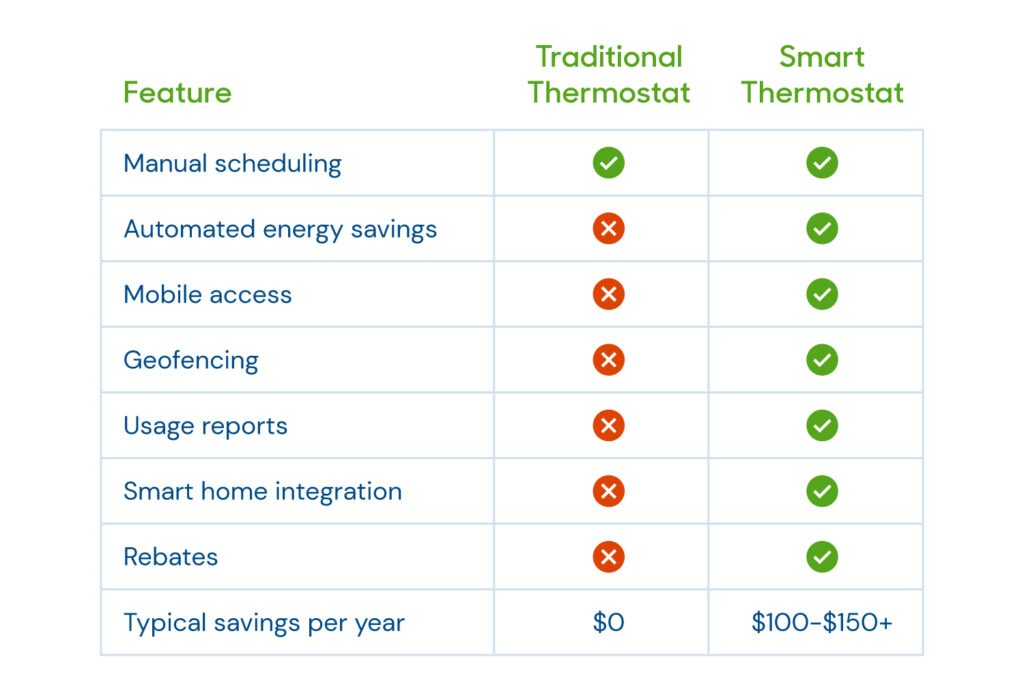
Note: Features may vary depending on the make and model of your thermostat. Not all local power companies participate in the TVA EnergyRight Smart Thermostat Rewards program.
Smart thermostats offer a powerful combination of energy savings, personalized comfort and modern convenience. With the ability to reduce heating and cooling costs by 10% or more, they’re a smart upgrade for anyone looking to lower their energy bills without sacrificing comfort.
Will a smart thermostat save money? Our research points to “YES.” Whether you’re tech-savvy or just looking for a set-it-and-forget-it solution, a smart thermostat can be a key player in your home’s energy efficiency strategy.
5 fun experiments to teach your kids about thermal energy.

Tired of the chorus of “I’m booooored,” radiating from your kids’ quarters? Build a solar updraft tower, conduct a cooler contest, bake ice cream, create an endothermic reaction, or make a thermometer. These five fun, safe and inexpensive experiments should keep everyone (supervision is always a good idea) productively occupied — for the afternoon, at least.

Build a solar updraft tower.
At full scale, solar updraft towers generate electricity by harnessing the sun’s power. They consist of a central stem that’s surrounded by a greenhouse-like structure. The warmed air rises through the stem, or core, and spins power-generating turbines.
Our version applies the same principles but at table-top scale.
Gather your scientific equipment:
- Black construction paper (about 20 x 20 inches)
- Smaller piece of construction paper (any color)
- Pencil
- Scissors
- Tape
- Piece of modeling clay, formed into a ball
- Wooden skewer
- Plastic needle or toothpick
- Instant read thermometer
- Lamp with incandescent light bulb or heat lamp
- Paper
- Optional: sunshine, and a wind-protected area outside
- Optional: timer
- Optional: white construction paper
Let’s get started:
- Roll your black construction paper into a tapered cone, with a 2” opening at the top, and a 4” opening at the bottom.
- Cut three more-or-less equally distanced, equally sized (approximately 2” long by half an inch tall) arches out of the bottom of your cone. These are your air inlets.
- Use this template to cut a 3” propeller out of construction paper. Bend your “blades” to a 45-degree downward angle.
- Carefully tape a plastic needle or toothpick to a wooden skewer with the pointy end facing upwards.
- Stick the base of the needle-topped skewer into the clay ball and center the black cone over the clay ball.
- Place the propeller on top of the needle. It should be balanced and able to turn freely, like a ceiling fan.
- Record the air temperature inside your tower.
- Now, place a utility lamp with an incandescent light bulb (incandescent bulbs use more energy and generate more heat; that’s why you should use LED bulbs for your home’s lighting fixtures) or a heat lamp at the base of the tower.
- After five minutes, record the air temperature inside your tower and observe what’s happening!
Visit ScienceBuddies.org to learn more about what happened and why!
Conduct a cooler contest.
Ever wondered how coozies keep your cola cold? Mystery solved! For an added dash of sibling rivalry, make two coolers and see which one is the coolest.
Gather your scientific equipment:
- 2-4 equally sized, large plastic food storage containers (one will need a tight-fitting lid).
- 2-4 small plastic food storage containers (they will need to fit comfortably, with room to spare, inside the large containers.
- Similarly sized ice cubes.
- Insulating materials such as cotton balls, bubble wrap, or craft feathers (you’ll need enough to mostly fill your large containers.
Let’s get started:
- Identify a flat, sunny outdoor surface — like a picnic table or sidewalk.
- Fill one of the large plastic containers with one of your insulating materials. This is your “cooler.”
- Place the smaller container in the middle of the larger containers and place an ice cube in each of the smaller containers.
- Quickly put the lid on top of your cooler container.
Which ice cube do you think will last the longest? If you made two coolers with different insulation, which cooler do you think will keep the ice cube cool the longest? How do you think your cooler’s insulation is like the insulation in your home?
SOURCE: Science Buddies
Bake your ice cream.
Generally, we don’t recommend eating your experiments. This is an exception to the rule.
Gather your scientific equipment:
- Mixing bowl
- 3 eggs (at room temperature)
- Cream of tartar
- Salt
- Vanilla extract
- Superfine sugar
- Whisk or electric mixer
- Store-bought cupcakes of your choice (ALT: sponge cake)
- Ice cream
- Parchment paper
- Baking sheet
- Oven
Let’s get started:
- Preheat your oven to 400° F
- Cut the top half of your cupcakes off and place the bottom half on a parchment-lined baking sheet. (Gee, whatever will you do with the tops?)
- Separate the three eggs. (TIP: Have your lab partner crack an egg into your hand and then gently move the yolk from one hand to the other. Let the whites drip into your experiment bowl and put the yolk in a different bowl.)
- Using a whisk or electric mixer, mix the egg whites with ¼ teaspoon cream of tartar, ¼ teaspoon salt, and ½ teaspoon vanilla. Continue mixing until the whites begin to sitffen and can form peaks. This may take a while, but don’t give up, it’s super cool!
- After your meringue (your flavored egg whites) has taken shape, slowly and gradually stir 1 cup of superfine sugar into your meringue.
- Quickly add a small scoop of ice cream to each cupcake half. Be sure the ice cream does not touch the edges of the cupcake.
- Quickly coat each cupcake/ice cream combo with the meringue foam. Make sure the meringue covers the cake and ice cream completely!
- Place the baking sheet on the bottom rack of the oven and set the timer for 10 minutes. Turn the oven light on and check every three minutes to make sure that the meringue is not burning or browning too quickly.
What part of this experiment is acting as insulation?
SOURCE: Scientific American
Create an endothermic reaction.
See how reactions move energy around! We recommend using the kitchen sink as your laboratory.
Gather your scientific equipment:
- Insulated cup
- Instant read thermometer
- Distilled white vinegar
- Baking soda
- Measuring cup
- Tablespoon
Let’s get started:
- Pour ¼ of a cup of vinegar into your insulated cup. Measure and record the temperature of the vinegar.
- Gradually add 1 tablespoon of baking soda into the cup and gently stir with your thermometer.
- Record your observations of temperature changes over time. Does the solution get hotter or colder as the reaction is occurring?
Source: Fizzics Education
Make a thermometer.
Definitely do NOT put this experiment to the taste test!
Gather your scientific equipment:
- Mason jar with straw lid
- Clear straw
- Play dough or modeling clay
- Water
- Rubbing alcohol
- Cooking oil (any kind)
- Food coloring
- Permanent marker
Let’s get started:
- Mix ¼ cup water, ¼ cup rubbing alcohol, a few drops of food coloring and a tablespoon of cooking oil in the mason jar.
- Make marks along the bottom half of your straw at half-centimeter intervals.
- Put the lid on and drop the straw into the mixture.
- Mold the play dough around the straw, sealing any gaps around the straw and holding the straw about ½” off the bottom of the jar.
- Place your thermometer outside in a sunny place and wait 10-20 minutes. Observe what happens.
- Next place it in a bowl of ice. Observe.
SOURCE: wikiHow
What is a mini split heat pump and how does it work?

If you’re researching energy-efficient ways to heat and cool your home, you may have stumbled upon something called a mini split. So, what is a mini split heat pump and how does it work? How is it different from a traditional furnace, radiator heat or heat pumps? Let’s dig in.
Industry experts may also refer to these energy-saving, two-in-one heating and cooling units as ductless heat pumps or ductless mini splits. (Looking for more information about conventional heat pumps, AKA dual fuel heat pumps and air source heat pumps, check out this article.)
We know it’s known by many names but what exactly is a mini split, and how does it work? Let’s find out! This article covers everything you need to know — from how mini split systems operate to why they’re a smart choice for homeowners looking to save energy, lower energy costs and increase comfort.
Find even more ways to save on energy. Take a free DIY Home Energy Assessment today.
What is a mini split heat pump?
A mini split heat pump is a fully electric heating, ventilation and air conditioning (HVAC) system that provides both heating and cooling. Unlike traditional central HVAC systems that rely on ductwork to distribute air throughout your home, ductless mini splits consist of two main components: an indoor air-handling unit (AKA the head unit) and an outdoor compressor/condenser combo.
These units are connected by a small conduit that houses the power cable, refrigerant tubing, suction tubing and a condensate drain.
Because they don’t require ducts, mini split heat pumps are often used in homes or buildings where installing or extending ductwork would be difficult or expensive — such as older homes, homes without existing ductwork, home additions, garages, detached accessory dwelling units (DADUs) or finished basements.
How does a mini split heat pump work?
A mini split heat pump uses the same basic technology as your refrigerator or traditional air conditioner; however, instead of generating hot or cool air, it transfers heat into or out of your home.
In the summer, refrigerant extracts heat from inside your home (expansion) and pumps it outside, where the heat is squeezed out (compression). In the winter, the compressor works as an evaporator, and the cycle is reversed.
Mini split cooling mode:
- The indoor unit absorbs and extracts heat from the air inside your room using a refrigerant-filled coil.
- The refrigerant carries — or pumps — the heat outside to the outdoor unit.
- The outdoor unit squeezes the heat out of the refrigerant and releases it into the outside air.
- Cool air is blown back into your room.
Mini split heating mode:
- The process is reversed.
- The outdoor unit pulls heat from the outside air — even in cold temperatures.
- The refrigerant carries this heat inside.
- The indoor unit pumps warm air into your space.
Thanks to this heat transfer process, mini split heat pumps are highly energy efficient, using 60%-70% less energy to heat your home than a traditional heating system like an electric furnace or radiator.
What are the benefits of a mini split heat pump?
1. They’re energy efficient.
Because mini splits don’t lose energy through ducts (which can account for up to 30% of energy use in traditional systems), they’re often more efficient than ducted HVAC systems. Many models are also ENERGY STAR®-certified and use inverter technology to adjust power use based on the current heating or cooling need.
2. You have more control over temperature zones in your home.
Mini splits give you the power to control the temperature in individual rooms or “zones.” Each indoor unit operates independently, so you can heat one room while cooling another, or turn off units in rooms that aren’t being used.
3. They’re (relatively) easy to install.
Without the need for ducts, mini split systems can be installed by qualified professionals in a variety of places. Wall-mounted units are the most common head unit, but there are also ceiling-recessed and floor-mounted models available.
Looking for a trusted HVAC contractor? Hire a contractor with confidence when you work with a TVA-vetted member of the Quality Contractor Network (QCN).
4. They’re quiet.
Mini split systems are praised for their quiet performance. The noisy compressor stays outside, and the indoor units are designed to operate with minimal sound, making them great for bedrooms, offices or media rooms.
5. They can help lower your energy bill.
While the upfront cost of a mini split system may be higher than a traditional window unit or space heater, the long-term savings in energy costs can be significant, especially if you’re replacing outdated, inefficient systems.
ENERGY STAR notes that “a typical household’s energy bill is around $1,900 annually, and almost half of that goes to heating and cooling.” ENERGY STAR-certified heat pumps are independently verified to save you energy and money, plus they use up to 60% less energy than standard home electric radiators.
How many indoor head units do you need?
One outdoor mini split unit can typically support up to four or five indoor air handlers, depending on the capacity of the system. The number of units you’ll need depends on the size of your home and how many zones you want to control individually.
Other sizing factors include your home’s ceiling height, number of occupants, doors and windows, and how well (or poorly) your home is insulated. (Need an insulation upgrade? Insulation and air sealing rebates are available.)
Your TVA-vetted QCN contractor can help determine the correct size and number of head units for your space using a load calculation based on square footage, insulation, window size and other factors.
What are the disadvantages of mini splits?
While there are a lot of benefits to installing a mini split, there are a few potential downsides to consider:
- Initial Cost: Installation can be more expensive than a window unit or baseboard heater.
- Aesthetics: Some homeowners don’t love the look of wall-mounted indoor units.
- Maintenance: Filters need regular cleaning and professional service is recommended annually.
Is a mini-split right for you?
If you’re looking for an energy efficient, flexible and powerful way to heat and cool your home, a mini split heat pump could be a smart choice. They’re especially well-suited for homes without ductwork, spaces with specific comfort needs and smaller homes.
Saving energy adds up, in a good way, with Smart Thermostat Rewards.

You’re invited to sign up for the new Smart Thermostat Rewards program, brought to you by TVA EnergyRight® and participating local power companies. Tell your friends and neighbors, too!
Smart Thermostat Rewards was carefully designed with input from residents like you and local power companies. This voluntary program rewards participants for using less energy during times of peak energy demand — like a winter cold snap or a summer heat streak.
Saving energy adds up, in a good way.
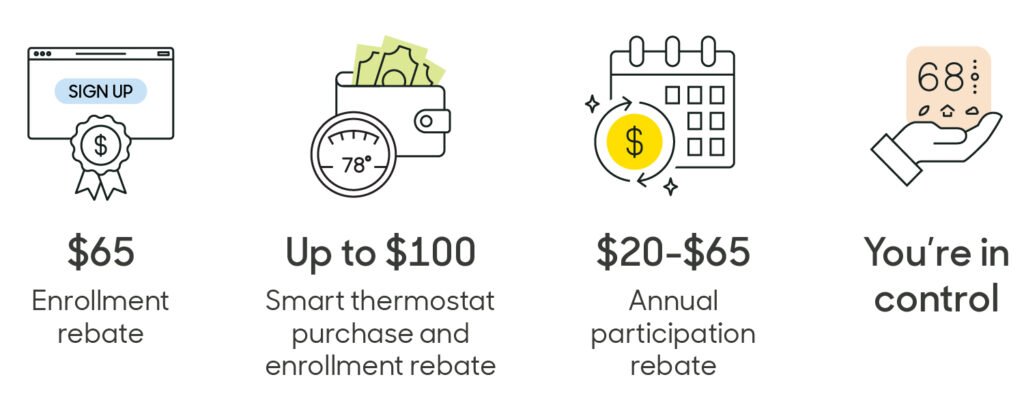
Frequently asked questions about Smart Thermostat Rewards.
What are the financial benefits of Smart Thermostat Rewards?
You can save on money energy by using less electricity during times of peak demand, plus you’ll also receive a $65 enrollment rebate. Year-round participants will receive an additional $65 annual participation rebate and summer-only participants will receive a $20 annual participation rebate.
What if I don’t have a qualifying smart thermostat?
You can purchase a qualifying Wi-Fi smart thermostat on the TVA EnergyRight Marketplace and receive an enrollment rebate of up to $100.
Why is TVA EnergyRight offering financial rewards for using less electricity?
When temperatures soar in the summer or plummet in the winter, demand for electricity increases.
Programs like Smart Thermostat Rewards help TVA make sure that electricity is available to the entire region during times of peak energy demand. They also help keep electricity more affordable for everyone.
How does the program work?
When you and your friends and neighbors enroll in Smart Thermostat Rewards, you’re agreeing to allow automatic adjustments of up to four degrees for a duration of up to four hours during times of peak demand (up to 60 hours per season). The more participants we have, the better it works for everyone!
Prior to an event, enrolled thermostats may be adjusted to pre-condition — pre-heat or pre-cool — a home so that customers remain comfortable while the event is taking place. Pre-conditioning may not always occur.
When do adjustments typically occur?
Typically, adjustments of up to four degrees, for up to four hours, occur between 6 a.m. and 10 p.m. Summer-only participants (for those who do not have electric heat) can expect events to be called between June 1 and September 30.
How will I know when a temperature adjustment is in progress?
Depending on the thermostat provider, notifications may appear on the thermostat or in your web/mobile application.
Can I opt out of an event or program?
Yes. Although you must maintain a 65% participation rate to remain in the program and receive the $65 (year-round) or $20 (summer-only) participation rebate, you can opt out of an event using your thermostat, mobile app or web browser. You can opt out of the Smart Thermostat Rewards program at any time by emailing TVAEnergyRightSmartThermostatRewards@energyhub.net and requesting to end participation.
Which smart thermostats qualify for the program?
Our participating smart thermostat partners include Alarm.com, Amazon, ecobee, Honeywell Home, Nest and Sensi.
How can I sign up for Smart Thermostat Rewards?
If you have a qualifying thermostat and your local power company is participating in the program, you can visit EnergyRight.com/smartthermostat to enroll.
NOTE: Terms, conditions and pricing are subject to change.
7 federal tax credits for energy efficiency upgrades.

Making energy efficient upgrades to your home can lower your energy bill, make your home more comfortable and reduce your environmental impact. Energy upgrades may also offer significant tax savings.
The federal government offers several tax credits to encourage homeowners and renters to invest in energy-saving improvements. Be sure to speak with your tax advisor for the latest information on local, state or federal tax credits.
Here are some of the top federal tax credits you can claim to make your home more energy efficient.
#1 — Residential Clean Energy Credit
This credit, formerly the Residential Energy Efficient Property Credit, allows homeowners to claim up to 30% of the cost of installing renewable energy systems (IRS.gov). Eligible systems include:
- Solar panels (photovoltaic systems)
- Solar water heaters
- Wind turbines
- Geothermal heat pumps*
- Battery storage systems
*If you’re considering a geothermal heat pump, check out our $3,000 rebate!
#2 — Energy Efficient Home Improvement Credit
Previously called the Nonbusiness Energy Property Credit, this tax credit was recently expanded (TurboTax). If you make qualifying improvements after January 1, 2023, you may be able to claim up to $3,200 annually for qualifying energy-efficient upgrades (IRS.gov), including:
- Insulation and airs ealing materials or systems*
- Heat pumps*
- Water heaters
- Exterior doors
- Exterior windows and skylights
*If you’re thinking about insulation, air sealing or having a new heat pump installed, reach out to a member of our Quality Contractor Network to learn more about incentives from TVA EnergyRight and your local power company.
Explore TVA EnergyRight rebates
#3 — Electric panel upgrade tax credit
If you’re upgrading your home’s electric panel to accommodate new energy-efficient systems, you can claim up to 30% of the cost, up to $600. This credit helps ensure your home’s electrical system can handle increased loads from new appliances or renewable energy installations (ENERGYSTAR.gov).
Source: Energy.gov – Tax Credits for Energy Efficiency
#4 — Energy efficient HVAC systems
As part of the Energy Efficient Home Improvement Credit, your heating, ventilation, and air conditioning (HVAC) systems may also qualify for a credit (ENERGYSTAR.gov). Tax credits may be available for installing:
- Energy-efficient air conditioners*
- Heat pumps*
- Furnaces
- Boilers
*Rebates from TVA EnergyRight and your local power company are also available on qualifying heat pumps, ductless mini-splits, and 15 SEER2 or higher central air conditioning units.
Central air conditioner rebates
#5 — Home energy audit tax credit
A professional home energy audit helps identify areas where your home is losing energy. The Energy Efficient Home Improvement Credit covers 30% of the cost of a home energy audit, up to $150 (Energy.gov). Find a TVA-vetted professional for your Home Energy Evaluation and start saving.
Or, if you’d rather start with a free, DIY Home Energy Assessment, we can help with that, too!
#6 — Energy-efficient water heaters
Replacing an old tank-style water heater with a more energy-efficient on-demand or heat pump model may qualify for a tax credit.
#7 — Smart thermostats
Smart thermostats “learn” your heating and air conditioning preferences (and your schedule) and adjust heating and cooling accordingly to optimize energy use. They may not be eligible for federal credits on their own, but installation costs may be eligible as part of a bigger HVAC upgrade.
Fortunately, we have you covered! Check out our Smart Thermostat Rewards program and learn more about our instant rebate. Or, check out our Smart Thermostat FAQs for more information.
DISCLAIMER: TVA EnergyRight and local power companies do not provide tax, legal or accounting advice. This blog is intended for informational purposes only and should not be relied on for tax, legal, or accounting advice. Consult your own tax, legal, and accounting advisors for more information.
What is a heat pump and how do they work?

We’ve already done a little digging into geothermal heat pumps — so, in this article, we’re shedding some light on the region’s most popular heating and cooling system: the heat pump.
If you’re looking for an energy-efficient way to heat and cool your home, you may have come across the term “heat pump.” But what is a heat pump, and how do they work?
What is a heat pump?
A heat pump is a versatile heating and cooling system that transfers heat from one place to another. Unlike a conventional furnace, which generates heat by burning gas or oil, a heat pump extracts heat from the air, ground, or water.
Heat pumps move heat inside during the winter and outside during the summer. Because heat pumps move heat rather than generate it, they can operate with significantly higher efficiency than conventional heating and cooling systems.
It also means that heat pumps are “twofers” — they do double duty as your heating system in the winter and your central air conditioning system in the summer.
How do heat pumps work?
Heat pumps function using a refrigeration cycle similar to that of an air conditioner. The main components of a heat pump include:
- Evaporator coil – Absorbs heat from the surrounding air, ground, or water.
- Compressor – Increases the temperature of the absorbed heat by compressing the refrigerant gas.
- Condenser coil – Releases the heat into your home in heating mode or expels heat outside in cooling mode.
- Expansion valve – Regulates refrigerant flow to maintain the correct temperature and pressure levels.
In the winter, the heat pump extracts heat from the outdoor air (even in cold temperatures) and moves it indoors. In the summer, the process reverses, and the heat pump removes heat from inside your home and releases it outdoors, keeping your home cool.
Do you have a heat pump?
You may be surprised to find out that you already have one! Our seven-state Valley region holds seven of the top 10 positions for states with the highest percentage of heat pumps.
What are the different types of heat pumps?
There are several different types of heat pumps — and we offer rebates on many of them! Federal tax credits may also be available.
- Air-source heat pumps – The most common type of heat pump, air source or dual fuel heat pumps extract heat from the outdoor air. Get a rebate of up to $800.
- Ground-source (geothermal) heat pumps – Use underground heat for increased efficiency but require extensive installation. Get a rebate of up to $3,000.
- Water-source (geothermal) heat pumps – Transfer heat to and from a water source, such as a lake or well. Get a rebate of up to $3,000.
- Ductless mini-split heat pumps – Ideal for homes without ductwork, providing zoned heating and cooling. Get a rebate of up to $800.
Energy efficiency and SEER2 ratings.
One of the biggest advantages of heat pumps is their high energy efficiency. The efficiency of air conditioners and heat pumps is measured using the Seasonal Energy Efficiency Ratio (SEER) for cooling and Heating Seasonal Performance Factor (HSPF) for heating. In January 2023, the U.S. Department of Energy updated its rating standards to SEER2 and HSPF2, which provides a more accurate measure of a unit’s real-world performance (Air Conditioning, Heating and Refrigeration Institute).
Understanding SEER2 ratings
- Higher SEER2 ratings indicate better cooling efficiency and use less electricity to cool your home.
- Higher HSPF2 ratings mean the heat pump is more efficient at heating, helping you save on winter heating costs.
- The minimum SEER2 rating for heat pumps in our southeastern region is 15.
When purchasing a new heat pump, looking for a model with a high SEER2 rating ensures lower energy consumption and reduced utility bills over time.
How heat pumps help you save money
A major advantage of installing a heat pump — whether it’s geothermal, dual fuel, or a ductless mini-split, is energy savings, which translates into lower utility bills (Energy.gov).
- Efficiency: Heat pumps use electricity to move heat rather than generate it, making them significantly more efficient than traditional heating systems.
- Lower operating costs: Because heat pumps work year-round for both heating and cooling, you can replace separate heating and cooling systems with a single unit, reducing maintenance costs.
- Rebates and incentives: Many federal, state and local programs offer rebates and tax credits for heat pump installations. Be sure to check out all of our rebates to make sure you’re maximizing your savings.
Environmental benefits of heat pumps
Beyond cost savings, heat pumps contribute to a more sustainable future by reducing carbon emissions. Since they use electricity instead of fossil fuels like natural gas or oil, they lower household greenhouse gas emissions. Pairing a heat pump with renewable energy sources such as solar power can further enhance sustainability.
Is a heat pump right for your home?
Our region is ideally suited for heat pumps and more and more homeowners are choosing these money-saving systems over conventional furnaces. If you’re thinking about upgrading your heating and air conditioning systems, reach out to a TVA-vetted member of the Quality Contractor Network to learn more.
With high efficiency ratings, SEER2-rated models, rebates from TVA EnergyRight and government incentives, now is a great time to consider upgrading to a heat pump. By making the switch, you can enjoy year-round comfort, lower energy costs, and a more sustainable home!

